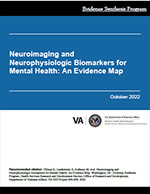
|
Recommended citation: |
Download PDF: Complete Report, Executive Summary, Report, Appendices
Although there were many eligible studies using neuroimaging and neurophysiologic data (mostly with MRI) for diagnosis and prognosis in depression, most were limited by small sample sizes and cross-sectional designs. Additionally, there was a relative lack of evidence on other mental health conditions and TBI; existing studies on these other conditions had similar methodological concerns. Future research should use larger samples with longitudinal data, as well as addressing other conditions and/or using other neuroimaging techniques.
Improving diagnosis and treatment for mental health conditions and TBI continues to be an important VA priority. The VA has been mandated to develop a plan for applying precision medicine to Veterans' healthcare and research in mental health. To assist with this mandate, we conducted an evidence map that provides descriptive information about the characteristics of existing studies that address diagnosis and/or prognosis of variety of mental health conditions and TBI using a wide range of neuroimaging and neurophysiologic data.
Of 313 eligible primary studies and 30 systematic reviews, most addressed depression (k=235 [17 reviews]); fewer examined bipolar disorder (k=51 [3 reviews]), PTSD (k=32 [2 reviews]), OCD (k=20 [1 review]), substance use disorders (k=20), TBI (k=15 [3 reviews]), and anxiety disorders (k=13 [3 reviews]). Three-quarters of primary studies used MRI-based techniques and a fifth employed EEG; two-thirds focused on diagnosis (nearly all were cross-sectional), the remaining on prognosis or treatment response. Primary studies generally included young and middle-aged adults; only 5 had participants with mean ages =65. Studies were conducted in diverse locations, with the most common being China, US or Canada; very few were conducted in more than 1 country. Overall, most of the evidence came from very small studies (total n<100). Only 14 primary studies included US Veterans or active military service members; 12 addressed PTSD and/or TBI, and 2 evaluated SUD.
Neuroimaging and Neurophysiologic Biomarkers for Mental Health: An Evidence Map (Management eBrief)